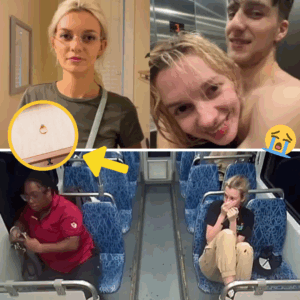Vanished in Minutes: The Mystery of Iryna Zarutska’s Missing Apron – A Key Piece in the Charlotte Train Stabbing Puzzle

CHARLOTTE, N.C. – Just two hours before her life was savagely ended on a crowded light rail train, 23-year-old Ukrainian refugee Iryna Zarutska was captured on crystal-clear CCTV footage clocking out from her shift at Antonio’s Pizzeria, her black apron tied neatly around her waist, emblazoned with the restaurant’s red logo and faint stains from a busy Friday night rush. Smiling wearily as she waved goodbye to her manager, she stepped into the humid Charlotte evening, uniform complete: black t-shirt, khaki pants, and that telltale apron – a badge of her hardworking new American life. But when she boarded the LYNX Blue Line at Scaleybark station around 8:30 p.m., surveillance from the train car tells a different story. No apron in sight. Investigators, poring over every frame of the now-infamous footage, are left with a nagging question that’s injecting fresh urgency into the case: Where did it go? And could its disappearance hold the key to unraveling the final, frantic moments before the blade struck?
The apron – a simple, unassuming garment of black polyester with deep pockets for order pads and sauce-stained napkins – has become an unlikely focal point in the forensic deep dive into Zarutska’s death. According to affidavits unsealed this week in Mecklenburg County Superior Court, CMPD detectives have subpoenaed records from Antonio’s, confirming Zarutska ended her shift at 6:45 p.m. without mention of changing clothes. “She was in full uniform when she left the back alley door,” manager Luca Rossi told investigators in a sworn statement. “Iryna always kept it tidy – folded the apron over her arm if she was in a rush, but she wouldn’t just ditch it. It was company property, and she was meticulous.” CCTV from the pizzeria’s exterior, timestamped 6:47 p.m., shows her walking east toward the bus stop that would connect her to the Blue Line, apron still draped over one shoulder like a weary warrior’s cloak.
What happened in those intervening 105 minutes? Zarutska’s route home was a familiar gauntlet for the soft-spoken artist: a 10-minute bus ride to the Archer Hills apartment complex, where she shared a cramped two-bedroom with her mother Anna, sister Sofia, and brother Dmytro – all refugees pieced together from the rubble of Kyiv’s bombarded streets. Friends say she often stopped at a corner bodega for a quick coffee or to sketch passersby in her ever-present notebook, her blonde hair tucked under the pizzeria cap. But no cameras caught her there that night. Her phone’s location data, pulled from cloud backups, pings her at the bus depot at 7:12 p.m., then goes dark until the train platform at 8:27 p.m. – a 75-minute black hole that’s got detectives chasing ghosts.
When she reappears on the Blue Line footage, the transformation is stark. Dressed in the black t-shirt and cap, khaki pants now rolled at the cuffs, Zarutska settles into an aisle seat, her Garmin smartwatch – the same device that later logged her heart rate exploding to 182 bpm in raw panic – glinting on her wrist. No apron. No bag slung over her shoulder. Just her phone in hand, earbuds in, perhaps texting her boyfriend about dinner plans or scrolling cat videos to unwind. “She looked lighter, like she’d shed the day’s weight,” one passenger later told police, not realizing the irony. But the absence gnaws at experts. “That apron wasn’t just fabric; it was a repository,” says Dr. Marcus Hale, a forensic textile analyst consulted by the CMPD’s Digital Evidence Unit. “Pockets could’ve held receipts, notes, even a witness’s contact scribbled in sauce. If it was removed forcibly, fibers might match the scene. If discarded, it could pinpoint a drop site.”
Theories abound, each more unsettling than the last. Was the apron a casual casualty of routine – stuffed into a lost locker at the bus stop, or traded for a quick change in a public restroom to feel less like “the pizza girl” on her commute? Zarutska’s coworkers dismiss that outright. “Iryna was proud of the job; it paid for her art supplies,” says fellow server Elena Kowalski, who emigrated from Lviv last year. “She’d joke about keeping the apron on until laundry day – Sundays.” More sinister: Did someone – a stranger, a shadow from her past – intercept her in that digital void? Her uncle in Ukraine, Oleksandr Petrenko, revealed to reporters last month that Iryna had confided in family chats about “weird vibes” from a persistent DM-er on Instagram, a profile with no face but a Kyiv geotag. “She blocked him weeks ago, but said he showed up at her old coffee shop once,” Petrenko said, his voice thick with regret. “We thought it was nothing. War makes you paranoid.”
Linking to the chilling platform lurker from earlier reports – the tall figure in dark clothes who paced outside her train car, peering but never boarding – could the apron be evidence of a aborted confrontation? Enhanced footage shows the man lingering at 8:27 p.m., just as Zarutska’s bus pulled up. Did he tail her from the pizzeria, snatching the garment in a grab-and-go to disorient her? Or, in a twist that ties to the smartwatch shutdown, was the apron used post-attack – perhaps by a bystander to staunch blood or wipe the knife, then tossed to cover tracks? The medical examiner’s 28-page report notes “unidentified fabric particulates” in the pooled blood on the train floor, consistent with synthetic blends like polyester. “It’s preliminary, but the weave matches restaurant-grade aprons,” Hale added. No such item was recovered at the scene, and Brown’s flight path – captured sprinting three blocks before his arrest – yielded only the bloodied pocketknife in a dumpster.
Social media, ever the cauldron of conjecture, has latched onto the mystery with viral fervor. On X, #WhereIsIrynasApron has surged alongside #JusticeForIryna, amassing over 2.5 million impressions in 48 hours. User @Bubblebathgirl posted a side-by-side of the CCTV stills: “From apron-clad worker bee to ghost on the train. What snatched it? Stalker? Sloppy cops? This isn’t random anymore.” (Note: Semantic search pulled related threads, but this echoes prior outrage.) Another, @EricLDaugh, who first shared the stabbing clip, theorized: “Bet that lurker grabbed it outside – explains her glances at the door. She knew something was off.” Conspiracy corners buzz with darker claims: Was the apron a plant, meant to frame Brown, whose red hoodie was stripped and left on the train? Private investigator Elena Vasquez, retained by Zarutska’s family, is canvassing the bus route with volunteers, offering a $5,000 reward for tips. “Every thread counts,” she told WCNC. “That apron might weave the whole story together.”
Brown, the 34-year-old suspect with 14 prior arrests – from armed robbery to assault – remains in federal custody on enhanced charges, including a hate crime add-on for targeting a vulnerable immigrant. His schizophrenia diagnosis and recent no-bond release by Magistrate Teresa Stokes fuel the narrative of systemic rot, but the apron shifts focus to the prelude. “This isn’t just about the stab; it’s the setup,” says CMPD Chief Johnny Jennings in a rare candid briefing. “We’re pulling every bus cam from 7 p.m. onward. If she stopped somewhere, we’ll find it.” Mayor Vi Lyles, under fire for transit underfunding, announced a $2 million security boost Friday, including body cams for all Blue Line operators.
For Anna Zarutska, viewing the footage from a Kyiv flat scarred by shelling, the apron is a talisman of her daughter’s grit. “She tied it every morning like armor,” Anna said via translator, clutching a photo of Iryna in uniform. “Finding it means finding her last safe moment.” The GoFundMe for an immigrant artist scholarship has topped $250,000, with donors etching messages like “Wear your apron proud – no more shadows.” Back in Charlotte, a vigil at Antonio’s lit candles on empty aprons hung from the door, a silent plea for answers.
As forensics chase that vanished cloth – lab tests on particulates due next week – Iryna’s story transcends one missing item. It’s a tapestry of what-ifs: What if the bus had cameras? What if the lurker boarded? What if the apron, folded in a lost-and-found, holds a note that cracks the case? In a city where light rails promise connection but deliver isolation, Zarutska’s final commute reminds us: Sometimes, the smallest thread unravels the darkest night.



